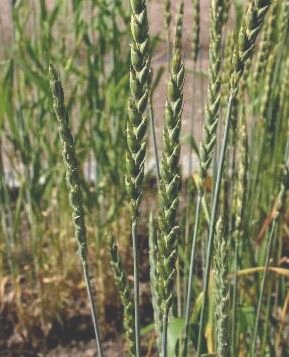
Spelt, also known as dinkel wheat or hulled wheat, is a species of wheat that has been cultivated since approximately 5000 BC.

Aegilops is a genus of Eurasian and North American plants in the grass family, Poaceae. They are known generally as goatgrasses. Some species are known as invasive weeds in parts of North America.

Common wheat, also known as bread wheat, is a cultivated wheat species. About 95% of wheat produced worldwide is common wheat; it is the most widely grown of all crops and the cereal with the highest monetary yield.

During 10,000 years of cultivation, numerous forms of wheat, many of them hybrids, have developed under a combination of artificial and natural selection. This diversity has led to much confusion in the naming of wheats. This article explains how genetic and morphological characteristics of wheat influence its classification, and gives the most common botanical names of wheat in current use. Information on the cultivation and uses of wheat is at the main wheat page.
Nano seed priming in botany and agriculture is a form of seed planting preparation in which the seeds are pre-soaked in nanoparticle solution. Seeds are considered to be an important part of crop life cycle as it influences the propagation of critical phases like germination and dormancy. Seed priming before sowing is considered to be one of the promising ways to provide value-added solutions to maximize the natural potential of seed to set the plant for maximum yield potential with respect to both quality and quantity. Positive effect on the shoot and root growth of seedlings of wheat when treated with iron-oxide nanoparticles. This innovative cost-effective and user-friendly method of biofortification has proven to increase grain iron deposition upon harvesting. Hence, the intervention of nanotechnology in terms of seed priming could be an economical and user-friendly smart farming approach to increase the nutritive value of the grains in an eco-friendly manner.

Triticum carthlicum Nevski, 1934, the Persian wheat, is a tetraploid wheat.

Leymus mollis is a species of grass known by the common names American dune grass, American dune wild-rye, sea lyme-grass, strand-wheat, and strand grass. Its Japanese name is hamaninniku. It is native to Asia, where it occurs in Japan, China, Korea, and Russia, and northern parts of North America, where it occurs across Canada and the northern United States, as well as Greenland. It can also be found in Iceland.
Triticum urartu, also known as red wild einkorn wheat, and a form of einkorn wheat, is a grass species related to wheat, and native to western Asia. It is a diploid species whose genome is the A genome of the allopolyploid hexaploid bread wheat Triticum aestivum, which has genomes AABBDD.

Triticum compactum or club wheat is a species of wheat adapted to low-humidity growing conditions. T. compactum is similar enough to common wheat that it is often considered a subspecies, T. aestivum compactum. It can be distinguished by its more compact ear due to shorter rachis segments, giving it its common name. In the United States of America, nearly all T. compactum is grown in dry areas of the Pacific Northwest.
Streptomyces gamaensis is a bacterium species from the genus of Streptomyces which has been isolated from soil from Gama in Chad. Streptomyces gamaensis has an antifungal activity.
Streptomyces tritici is a bacterium species from the genus of Streptomyces which has been isolated from rhizosphere soil from the wheat-plant Triticum aestivum.
Glycomyces dulcitolivorans is a bacterium from the genus of Glycomyces which has been isolated from rhizospheric soil from the plant Triticum aestivum.
Glycomyces rhizosphaerae is a bacterium from the genus of Glycomyces which has been isolated from rhizospheric soil of a soybean plant from Harbin in China.
"Glycomyces tritici" is a bacterium from the genus of Glycomyces which has been isolated from rhizospheric soil from a wheat-plant.
Ernest Robert Sears was an American geneticist, botanist, pioneer of plant genetics, and leading expert on wheat cytogenetics. Sears and Sir Ralph Riley (1924–1999) are perhaps the two most important founders of chromosome engineering in plant breeding.
Streptomyces triticisoli is a bacterium species from the genus of Streptomyces which has been isolated from rhizosphereic soil of the plant Triticum aestivum.
Streptomyces triticagri is a bacterium species from the genus of Streptomyces which has been isolated from rhizosphereic soil of the plant Triticum aestivum from Zhumadian in China.
Streptomyces triticirhizae is a bacterium species from the genus of Streptomyces which has been isolated from rhizosphereic soil.
Streptomyces oryziradicis is a bacterium species from the genus of Streptomyces which has been isolated from rhizosphereic soil of a rice plant from the Northeast Agricultural University in Harbin in China.
Streptomyces triticiradicis is a bacterium species from the genus of Streptomyces which has been isolated from rhizosphereic soil from wheat. Streptomyces triticiradicis has antifungal properties.






